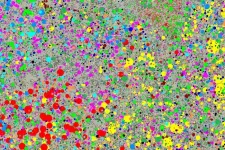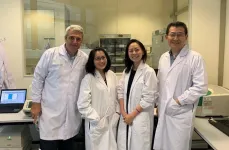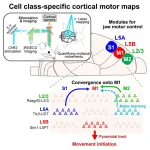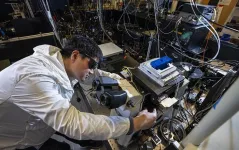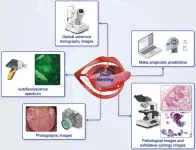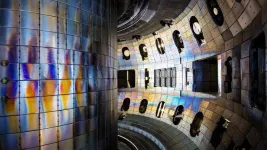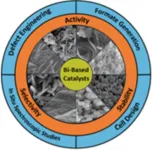(Press-News.org) The brain creates internal 'maps' to help us navigate and learn from our surroundings, but how these maps form remains a challenge to understand. Now, a study led by Liset M. de la Prida at the Cajal Neurosciences Center (CNC-CSIC) in Madrid, in collaboration with Imperial College London, offers a fresh perspective on how spatial and experiential information is encoded in the hippocampus, a key brain region for navigation and memory.
The study published today in Neuron, reveals that two types of hippocampal neurons work complementarily in mice to generate spatial maps that are more sophisticated and adaptable than previously thought. The findings open new avenues for understanding how the brain processes and represents spatial information, and could have implications for the future development of treatments for neurological disorders related to memory and orientation, such as in Alzheimer's disease.
The researchers found that two distinct subpopulations of pyramidal neurons, classified as superficial and deep based on their location in the hippocampus, respond differently during movement and rotation, allowing the brain to generate complementary geometric representations.
The study shows that deep pyramidal neurons respond to local changes, such as the position of furniture in a room. In contrast, superficial pyramidal neurons maintain a more stable spatial representation, focused on global features like the orientation of windows or doors. This stability is crucial for maintaining a consistent reference of the environment.
This study builds on research recognized with the 2014 Nobel Prize awarded to May-Britt and Edvard Moser, along with John O’Keefe, for their discoveries on place and grid cells, which form the foundation of the brain’s positioning system. Liset M. de la Prida’s findings expand on these discoveries, offering a deeper understanding of how the hippocampus encodes and processes spatial information by integrating different frames of reference.
Space, speed and direction
To study these representations, the team used simple maze-like corridors with visual and tactile cues, where mice could run back and forth. They discovered that deep-layer neurons were more tuned to space, speed, and the direction of movement than superficial-layer neurons. Interestingly, deep neurons responded to nearby landmarks, whereas superficial neurons were more attuned to visual cues in the broader room environment.
“Hippocampal neurons create abstract spatial representations that act as a map, enabling orientation and memory of past experiences. Until now, it was unclear how different neuron types contributed to these abstract maps, as these representations emerge from collective activity. It’s like trying to determine which musicians in an orchestra are responsible for rhythm and which for melody—while all of them contribute, some play key roles in the final outcome,” says Liset M. de la Prida.
The breakthrough was made possible by advanced imaging techniques that allow the simultaneous visualization of hundreds of neurons of each type. “We used two different-colored sensors to track the activity of both superficial and deep cells in real time,” explains Juan Pablo Quintanilla, the co-author responsible for these experiments. This microendoscopic cellular imaging technique was established for the first time in Spain at the Cajal Neurosciences Center of the Spanish National Research Council (CSIC).
Maps updated in real time
Another key innovation of the study was the use of topological methods—a branch of mathematics that studies the properties of geometric objects—to decode the structure of these abstract neuronal maps. As mice explored the corridors, the hippocampal maps formed by the activity of hundreds of neurons from each subpopulation took the shape of three-dimensional rings.
When the environment changes—such as after rearranging furniture in a room—deep and superficial pyramidal neurons react differently. This allows the brain to update its spatial map while preserving coherent and flexible information about location and orientation despite external changes.
These different spatial representations (local versus global) coexist in parallel within the hippocampus. This ability to maintain multiple reference frames simultaneously is a remarkable feature of cognitive maps.
“The maps generated by these two neuronal subpopulations are interwoven, representing both global (e.g., the room) and local (e.g., the furniture) information,” explains Julio Esparza, a biomedical engineer responsible for the topological analyses.
To test this flexibility, the researchers used chemogenetics to temporarily “silence” specific cell types. “We found that we could rotate the internal spatial maps and reorient the rings by selectively silencing superficial or deep neurons,” Esparza explains.
The brain’s ability to create mental maps can be used to improve memory, as in the ‘memory palace’ technique. This method helps people remember information by imagining familiar places, like their home or neighborhood, and mentally placing ideas in different spots to make them easier to recall.
The findings from the CSIC team open new avenues for understanding how the brain processes and represents spatial information and could have implications for developing future treatments for memory-related neurological disorders, such as Alzheimer’s disease.
END
CSIC researchers discover how the brain builds sophisticated maps to navigate and remember the world
Until now, it was unknown how different types of neurons contribute to the representation of these abstract maps
2025-02-26
ELSE PRESS RELEASES FROM THIS DATE:
New spatial mechanism for the coexistence of tree species
2025-02-26
The data sets are very large: with more than 75 permanent forest dynamics plots in 29 countries worldwide, the Forest Global Earth Observatory network (ForestGEO) of the Smithsonian Tropical Research Institute (STRI) provides excellent forest inventories for investigating the dynamics of forest ecosystems and better understanding the processes that drive the structure and function of forests. On these 20-to-50-hectare plots, every single tree with a diameter not much larger than a pencil has been identified, measured and mapped every five years, often totalling more than 200 000 trees. The two UFZ researchers, Dr. Thorsten Wiegand ...
City of Hope research features myeloma study, cancer surgery and more
2025-02-26
This roundup highlights a common drug that can help treat multiple myeloma, a paper analyzing the benefit of a colorectal surgery follow-up test, recommendations for implementing remote patient monitoring for care received before, during and after surgery, details on how often women with an elevated breast cancer risk are receiving enhanced screenings, and clinical trial results for a new chimeric antigen receptor (CAR) T cell therapy targeting B cell acute lymphoblastic leukemia.
To learn more about research at City of Hope, one of the largest and most advanced cancer research and treatment organizations in the U.S. with its ...
A*STAR spin-off NalaGenetics implements nationwide drug reaction screening for leprosy patients in Indonesia
2025-02-26
SINGAPORE – NalaGenetics, a spin-off from A*STAR Genome Institute of Singapore (A*STAR GIS), will be transforming leprosy treatments in Indonesia with a nationwide genetic screening programme with their PGx1301 diagnostic kit. Set to launch in the fourth quarter of 2025, this initiative builds on a successful five-year pilot test in East Indonesia, which demonstrated the effectiveness of precision medicine in preventing life-threatening adverse drug reactions (ADRs).
As part of this programme, up ...
Unraveling the brain’s hidden motor modules
2025-02-26
For nearly a century, scientists have known that different parts of the human brain’s cortex control different body movements. This fundamental discovery dates to the 1930s, when neurosurgeons used electrical stimulation to map how different cortical regions correspond to different body parts.
But can these regions be further broken down into even smaller functional components? Researchers have long suspected that cortical units for specific body movements are more complex than simple patches in the cortex. Studies have identified various types of neurons stacked in multiple layers across the neocortex, but without a clear picture of how these ...
New photon-avalanching nanoparticles could enable next-generation optical computers
2025-02-26
A research team co-led by Lawrence Berkeley National Laboratory (Berkeley Lab), Columbia University, and Universidad Autónoma de Madrid has developed a new optical computing material from photon avalanching nanoparticles.
The breakthrough – which the team published recently in the journal Nature Photonics – paves the way for fabricating optical memory and transistors on a nanometer size scale comparable to current microelectronics. This approach offers a path toward realizing smaller, faster components for next-generation ...
Current status and future perspectives on early detection and diagnosis of colorectal cancer in China
2025-02-26
Colorectal cancer (CRC) is the second most commonly diagnosed cancer in China and a leading cause of cancer-related mortality. Despite improvements in treatment, the survival rate remains lower than in Western and other Asian countries due to late-stage diagnosis. Given that CRC typically develops over a prolonged period from precursor lesions, early detection and timely intervention are crucial for improving patient outcomes. However, CRC screening in China faces several challenges, including regional disparities, economic constraints, and limited public awareness. Recent advancements in non-invasive diagnostic tests, innovative imaging techniques, and ...
Program’s expansion boosts student research opportunities
2025-02-26
Aerospace engineering senior Philip Wilson attended an American Institute of Aeronautics and Astronautics (AIAA) conference. Rohit Raut, a senior physics major, presented his work at a nuclear research symposium, and senior biology major Jaden Rankin had the opportunity to feature her research at an entomology conference.
These and other University of Texas at Arlington students were able to showcase their original research at major symposiums thanks to UTA’s expansion of its popular undergraduate research program that provides funding for select students to present at academic conferences.
“At the conference, I presented my work on rotating ...
Deep learning in the diagnosis and prognosis of oral potentially malignant disorders
2025-02-26
Oral cancer remains a serious global health concern due to its high morbidity and mortality rates, primarily caused by late-stage diagnosis. The presence of oral potentially malignant disorders (OPMDs) provides an opportunity for early intervention, as these lesions precede the development of oral squamous cell carcinoma. However, the accurate detection and classification of OPMDs remain challenging due to their diverse clinical presentations. Conventional diagnostic methods, including visual examination and histopathological ...
Some fuel lodges in the inner walls of fusion vessels. Researchers now have a better idea of how much.
2025-02-26
To develop a practical fusion power system, scientists need to fully understand how the plasma fuel interacts with its surroundings. The plasma is superheated, which means some of the atoms involved can strike the wall of the fusion vessel and become embedded. To keep the system working efficiently, it’s important to know how much fuel might be trapped.
“The less fuel is trapped in the wall, the less radioactive material builds up,” said Shota Abe, a staff research physicist at the U.S. Department of Energy’s (DOE) Princeton Plasma Physics Laboratory (PPPL).
Abe is the lead researcher on a new study published in Nuclear ...
Bismuth-based catalysts: Promising candidates for electrochemical CO2 reduction to formate
2025-02-26
The electrochemical reduction of CO2 has been recognized as a promising strategy to convert ambient atmospheric CO2 into valuable products. Bismuth-based catalysts have garnered the widespread attention of researchers due to their cost-effectiveness, low toxicity, and high natural abundance. Significant progress has been made toward enhancing the reactivity of catalyst structures through innovative synthesis techniques and engineering. Advances include the use of flow cells and membrane electrode assembly (MEA) cells to attain high cathodic current densities of over 200 mA cm-2 with superior ...
LAST 30 PRESS RELEASES:
On-demand upgraded recycling of polyethylene and construction of sustainable multifunctional materials based on the "LEGO" strategy
New "Stomata in-sight" system allows scientists to watch plants breathe in real-time
Anorexia nervosa may result in long-term skeletal muscle impairment
Narrative-based performance reviews deemed fairest by employees
New insights reveal how advanced oxidation can tackle emerging water pollutants
New review shows how biomass can deliver low-carbon gaseous fuels at scale
Climate change is quietly rewriting the world’s nitrogen cycle, with high stakes for food and the environment
Study finds SGLT-2 inhibitors linked to lower risk of diabetic foot nerve damage
Microbes may hold the key to brain evolution
Study examines how the last two respiratory pandemics rapidly spread through cities
Gender stereotypes reflect the division of labor between women and men across nations
Orthopedics can play critical role in identifying intimate partner violence
Worms as particle sweepers
Second spider-parasitic mite described in Brazil
January 2026 issues of APA journals feature new research on autism, pediatric anxiety, psychedelic therapy, suicide prevention and more
Private equity acquired more than 500 autism centers over the past decade, new study shows
New cervical cancer screening guidelines from the US Department of Health and Human Services
Estimated burden of COVID-19 illnesses, medical visits, hospitalizations, and deaths in the US from October 2022 to September 2024
Smartphone use during school hours by US youth
Food insecurity and adverse social conditions tied to increased risk of long COVID in children
Earliest, hottest galaxy cluster gas on record could change our cosmological models
Greenland’s Prudhoe Dome ice cap was completely gone only 7,000 years ago, first GreenDrill study finds
Scientific validity of blue zones longevity research confirmed
Injectable breast ‘implant’ offers alternative to traditional surgeries
Neuroscientists devise formulas to measure multilingualism
New prostate cancer trial seeks to reduce toxicity without sacrificing efficacy
Geometry shapes life
A CRISPR screen reveals many previously unrecognized genes required for brain development and a new neurodevelopmental disorder
Hot flush treatment has anti-breast cancer activity, study finds
Securing AI systems against growing cybersecurity threats
[Press-News.org] CSIC researchers discover how the brain builds sophisticated maps to navigate and remember the worldUntil now, it was unknown how different types of neurons contribute to the representation of these abstract maps
